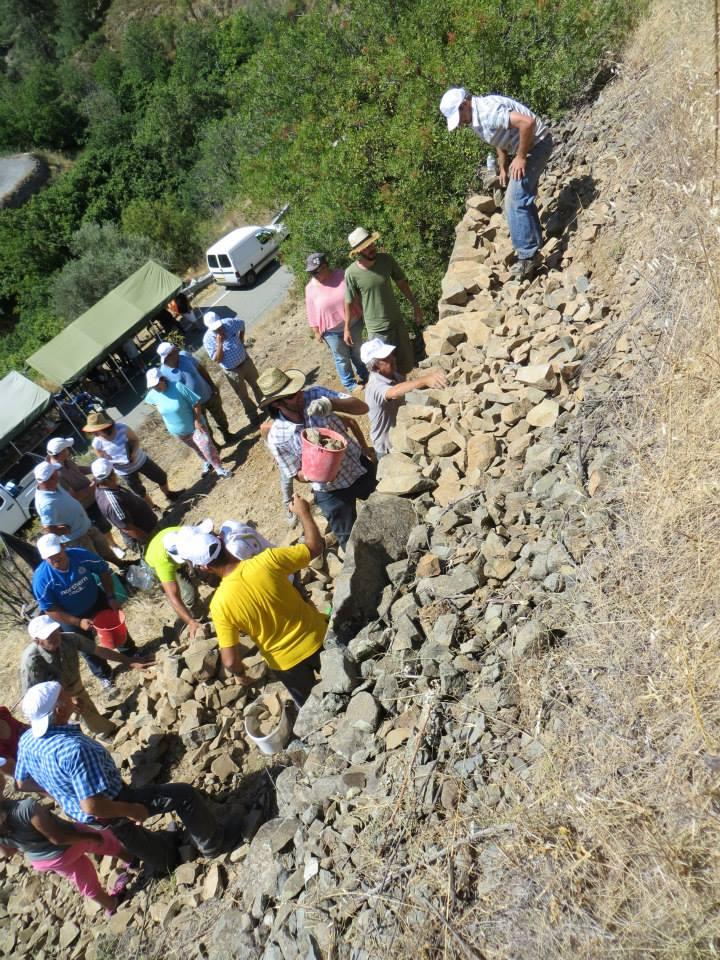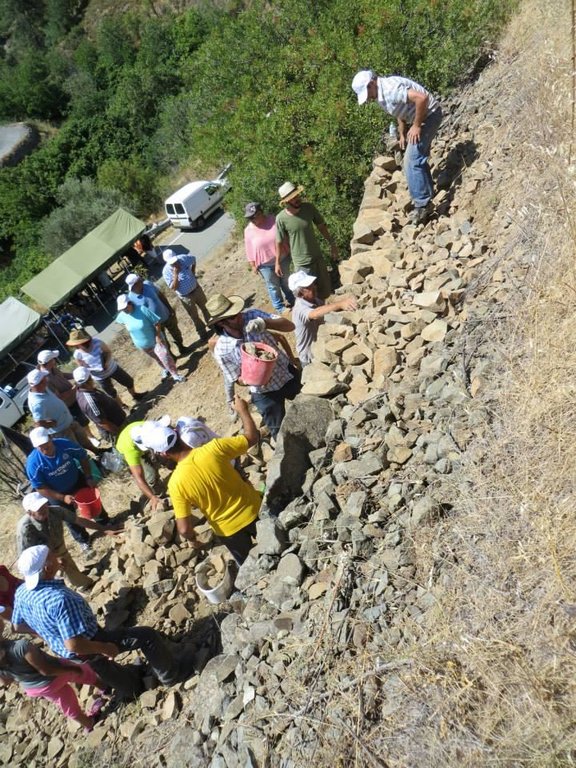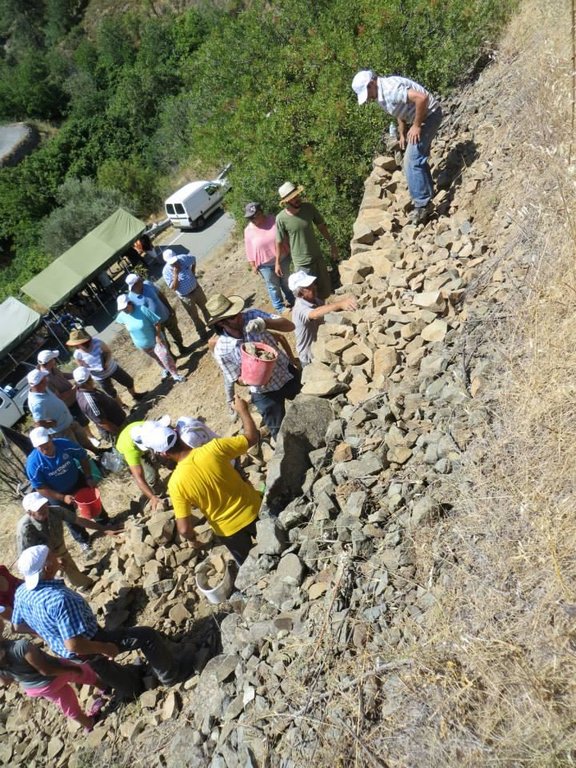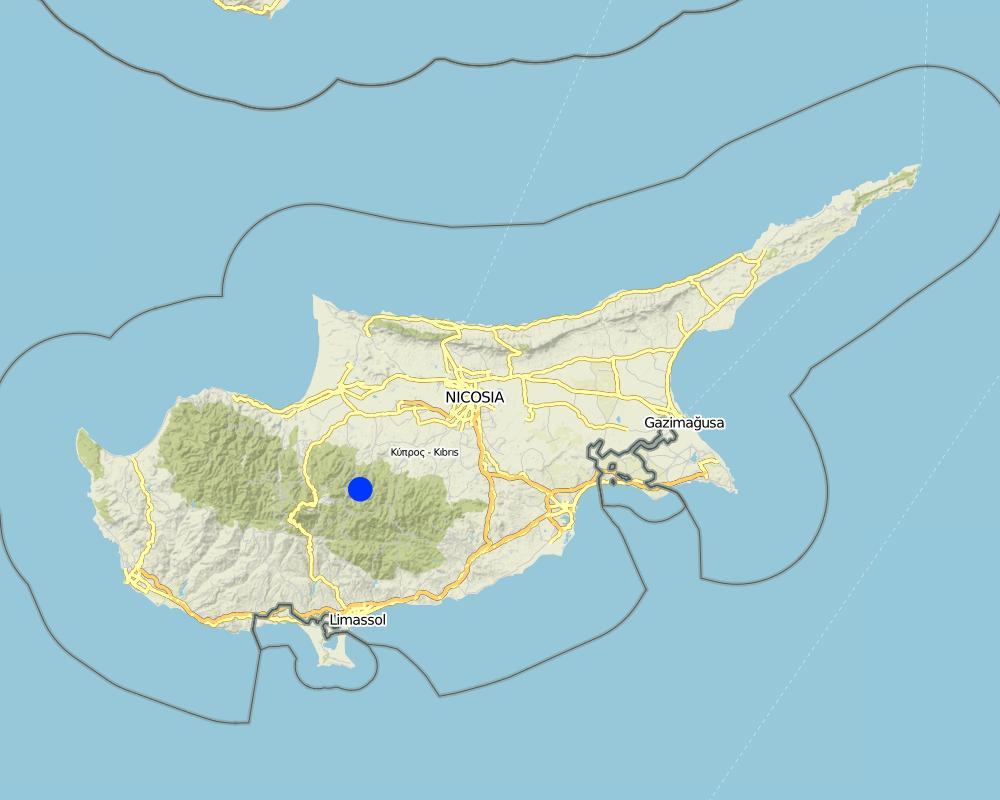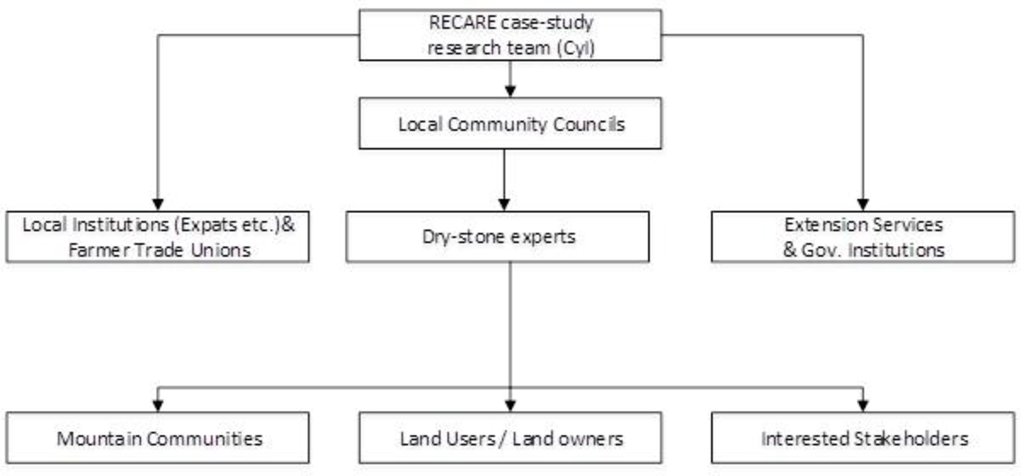Community-based maintenance and rehabilitation of agricultural terraces in mountain environments [Chipre]
- Creación:
- Actualización:
- Compilador: Christos Zoumides
- Editor: –
- Revisor: Fabian Ottiger
Κοινοτική συμμέτοχη για συντήρηση και αποκατάσταση ορεινών γεωργικών αναβαθμίδων (Greek)
approaches_2537 - Chipre
Visualizar secciones
Expandir todo Colapsar todos1. Información general
1.2 Detalles de contacto de las personas de referencia e instituciones involucradas en la evaluación y la documentación del Enfoque
Especialista MST:
Burggemann Adriana
The Cyprus Institute
Nicosia
Chipre
Nombre del proyecto que facilitó la documentación/ evaluación del Enfoque (si fuera relevante)
Preventing and Remediating degradation of soils in Europe through Land Care (EU-RECARE )Nombre de la(s) institución(es) que facilitaron la documentación/ evaluación del Enfoque si fuera relevante)
The Cyprus Institute (The Cyprus Institute) - Chipre1.3 Condiciones referidas al uso de datos documentados mediante WOCAT
¿Cuándo se compilaron los datos (en el campo)?
01/09/2015
El compilador y la/s persona(s) de referencia claves aceptan las condiciones acerca del uso de los datos documentados mediante WOCAT :
Sí
1.4 Referencia/s al/los Cuestionario(s) de Tecnologías MST
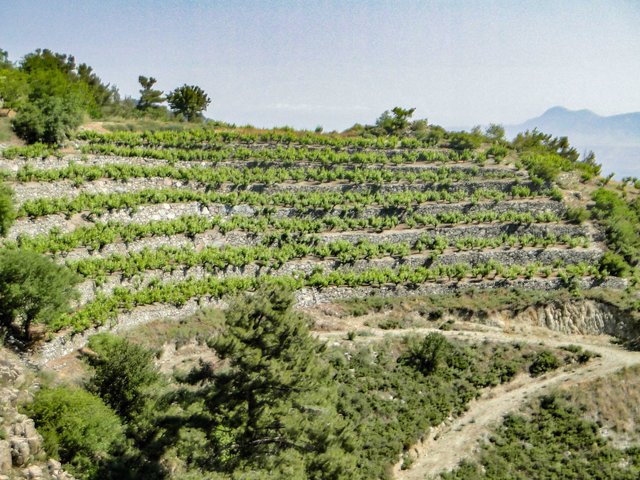
Agricultural terraces with dry-stone walls [Chipre]
Dry-stone terraces built to create agricultural land, minimise soil erosion and retain soil moisture on steep mountain slopes.
- Compilador: Christos Zoumides
2. Descripción del Enfoque MST
2.1 Breve descripción del Enfoque
Maintenance and rehabilitation of traditional dry-stone terrace walls for agricultural use, through science-society cooperation, community engagement and motivation, and assistance to land users.
2.2 Descripción detallada del Enfoque MST
Descripción detallada del Enfoque MST:
Aims / objectives: The main objective of the approach is the restoration and rehabilitation of traditional dry-stone terraces in Mediterranean mountain environments. Large areas around mountain communities have been converted to agricultural terraces. The depopulation of these rural mountain communities and the high farming costs have led to the gradual reduction of farming activities. Consequently, many of the mountain terraces are no longer cultivated and dry-stone walls are not well maintained, causing a domino effect of collapsing terraces. Soil erosion by water has been identified as the main soil threat in degraded and poorly vegetated terraces.
The approach has been developed by the Cyprus Institute research team and aims at motivating the mountain communities, land users/owners, local institutions and other interested stakeholders to better organise themselves and collaborate and join forces in maintaining these terraces.
Methods: The approach is based on participatory principles. More precisely, the science-society cooperation approach is materialised through the organization of practical (hands-on) public events, where dry-stone experts guide the participants, land users/owners, local population, expats (families that have moved to the urban areas) and scientific stakeholders, in collectively maintaining collapsed and/or poorly maintained terraces. All parties engaged in the implementation of the approach on voluntary basis.
Stages of implementation: A pool of local and external stakeholders was prepared by the research team using snowball sampling. Key stakeholders identified include community leaders, land users/owners, dry-stone experts, local institutions, agricultural extension services and farmer unions.
Leaders of the three mountain communities agreed to co-organise with the research team one participatory terrace rehabilitation event in each community. Land users/owners, expats and other interested stakeholders (general public) were identified as the main target groups of these events. Each community identified dry-stone experts that were willing to work and lead the workshops on voluntary basis. Demonstration sites were selected by the research team, the community leaders and dry-stone experts, based on the extent of terrace degradation, accessibility/visibility of the site and feasibility criteria. Farmer unions and extension service officers were also engaged in the process. The events were advertised through social media, as well as with flyers and posters in central locations within the communities.
During the events, information was provided by researchers and dry-stone experts to raise the awareness of participants on the environmental and cultural importance of dry-stone terraces. In addition, the learning-by-doing process was guided by experts who explained to the participants the best practices in reconstructing the collapsed terraced walls.
Three public events were organized in the first year and a similar set of three events will be organized in the second year. Additional funds are being sought to continue these activities. The sustainability of communal terrace maintenance will also be discussed with the community leaders and active volunteers during the second year.
Role of stakeholders: The research team conceptualised the approach. The organisation tasks for the participatory rehabilitation events were shared among the research team and the local communities. Expats (families that have moved to the urban areas) associations and farmer unions informed their members to join the events. Dry-stone experts had the leading role during the events, as the reconstruction of collapsed terrace walls was based on their guidance. Extension service officers provided information on available subsidy schemes. During the events all stakeholders, including land users/owners and other interested people, worked together to maintain the terraces.
Other important information: The events attracted people beyond the stakeholders originally identified; the approach was adopted by other projects/communities in Cyprus.
2.3 Fotos del Enfoque
2.5 País/ región/ lugares donde el Enfoque fue aplicado
País:
Chipre
Región/ Estado/ Provincia:
Nicosia
Especifique más el lugar :
Northeast Pitsilia
Map
×2.6 Fechas de inicio y conclusión del Enfoque
Indique año del inicio:
2015
Año de conclusión (si el Enfoque ya no se aplica):
2018
2.7 Tipo de Enfoque
- Recent local initiative in the framework of the RECARE research project
2.8 Propósitos/ objetivos principales del Enfoque
The Approach focused mainly on SLM with other activities (terrace maintenance, hands-on training, community conservation, participatory approach, stakeholder engagement, awareness-raising)
• To strengthen science-society cooperation in solving land degradation issues in terraced mountain environments.
• To build capacity for planning, organisation and implementation of participatory soil conservation activities, eventually leading to sustainable local institutions that maintain traditional know-how and specialised in terrace maintenance.
• To improve joint learning activities between farmers, terrace experts and interested stakeholders.
• To rehabilitate abandoned and collapsed terraces, reduce soil erosion and maintain the production capacity of soils in Troodos Mountains.
The SLM Approach addressed the following problems: • Collapsing of dry-stone walls, surface run-off and loss of soil (erosion) in sloping land that has been accumulated behind the terrace walls
• Depopulation of mountain rural communities and land abandonment
• Loss of indigenous knowledge
• Weak institutional organisation and limited incentives (low economic returns) for terrace maintenance
2.9 Condiciones que facilitan o impiden la implementación de la/s Tecnología/s aplicadas bajo el Enfoque
normas y valores sociales/ culturales/ religiosos
- impiden
Land abandonment, rural depopulation, lack of motivation.
Treatment through the SLM Approach: Organise frequent terrace maintenance events to stimulate interest, invite and engage expats to participate.
disponibilidad/ acceso a recursos y servicios financieros
- impiden
Low economic return from terrace agriculture.
Treatment through the SLM Approach: Engage, motivate and train volunteers through public terrace maintenance events.
entorno institucional
- impiden
There are no formal or informal institutions for terrace rehabilitation.
Treatment through the SLM Approach: The sustainability of communal terrace maintenance will be discussed with the community leaders and active volunteers during the second year.
marco de trabajo legal (tenencia de tierra, derechos de uso de tierra y agua)
- impiden
Terraced land is privately owned; no maintenance can be done without the approval of land owners. Demonstration sites are privately owned; the rehabilitation events on terraces were undertaken with the approval of land owners.
Treatment through the SLM Approach: Community leaders request the approval of land owners.
conocimiento de MST, acceso a apoyo técnico
- impiden
Loss of indigenous knowledge
Treatment through the SLM Approach: The terrace events are led by terrace artisans (dry-stone experts) to practically demonstrate and pass the technical know-how to the next generation. Efforts were made to engage terrace experts from different communities.
carga de trabajo, disponibilidad de mano de obra
- impiden
Terrace maintenance is a laborious activity.
Treatment through the SLM Approach: The pubic terrace maintenance events aim to build the capacity of a large group of people (volunteers) to engage in terrace maintenance.
3. Participación y roles de las partes interesadas involucradas
3.1 Partes interesadas involucradas en el Enfoque y sus roles
- usuarios locales de tierras/ comunidades locales
Land users including terrace artisans
Land users were involved as individuals. Representatives of farmers unions were engaged in the process
- investigadores
The Cyprus Institute (research institution)
Terrace experts, researchers and extension services
- sector privado
The Cyprus Institute (research institution)
- gobierno local
Local community councils
- gobierno nacional (planificadores, autoridades)
- organización internacional
- People (volunteers) that attended the hands-on events
Participants of the event (mountain communities, interested stakeholders)
Si varias partes interesadas estuvieron involucradas, indique la agencia principal:
The approach was primarily designed by The Cyprus Institute (research institution) [1]. The rehabilitation events are co-organised with the support of local community councils, land users and terrace experts [2].
3.2 Involucramiento de los usuarios locales de tierras/ comunidades locales en las distintas fases del Enfoque
| Involucramiento de los usuarios locales de tierras/ comunidades locales | Especifique quién se involucró y describa las actividades | |
|---|---|---|
| iniciación/ motivación | interactivo | Jointly developed by The Cyprus Institute (research institution) and local community leaders |
| planificación | interactivo | Jointly developed by a research institution, terrace artisans and local community leaders |
| implementación | interactivo | Jointly implemented by all stakeholders involved |
| monitoreo y evaluación | ninguno | Monitoring and evaluation of the approach and the restored terraces is undertaken by The Cyprus Institute scientists |
| Research | ninguno |
3.3 Flujograma (si estuviera disponible)
Descripción:
The research team identified key stakeholders using snowball sampling; these include community leaders, dry-stone experts, local institutions, agricultural extension services and farmer unions. Community leaders agreed to co-organise with the research team community-based terrace rehabilitation events; land users/owners, mountain communities and other interested stakeholders (general public) were identified as the main target groups of these participatory events. Dry-stone experts had the leading role during the events, as the reconstruction of collapsed terrace walls was based on their guidance. During the events all stakeholders, including land users/owners and other interested people, worked together to maintain the terraces. In addition, information was provided by researchers to raise the awareness of participants on the environmental and cultural importance of dry-stone terraces.
Autor:
Christos Zoumides
3.4 La toma de decisiones en la selección de Tecnología(s) MST
Las decisiones para la selección de la/s Tecnología(s) fueron tomadas:
- by SLM specialists (researchers) in collaboration
Explique:
The construction and maintenance of dry-stone terrace walls is an indigenous technology which is applied by land users and terrace artisans (dry-stone wall expert builders) that have the required skills and technical know-how. The initiative was taken by SLM specialists who are concerned about the land degradation and abandonment in mountain terrace areas.
Decisions on the method of implementing the SLM Technology were made by mainly by SLM specialists with consultation of land users. The implementation stage of terrace maintenance is led by terrace experts, who have the required know-how. During the hands-on events, they explain the appropriate techniques; land-users and participants of the events help the experts in maintaining and re-constructing the collapsed dry-stone walls and therefore learn from direct experience.
4. Apoyo técnico, fortalecimiento institucional y gestión del conocimiento
4.1 Construcción de capacidades / capacitación
¿Se proporcionó la capacitación a usuarios de tierras/ otras partes interesadas?
Sí
Especifique quién fue capacitado:
- usuarios de tierras
- Participants of the events
Si fuese relevante, también especifique género, edad, estatus, etnicidad, etc.
Both men and women of all ages.
Forma de capacitación:
- áreas de demostración
Temas avanzados:
How dry-stone terraces are restored and maintained (technique) and their importance in reducing soil erosion in mountain slopes (awareness).
4.2 Servicio de asesoría
¿Los usuarios de tierras tienen acceso a un servicio de asesoría?
Sí
Especifique si servicio proporcionado se realizó:
- en centros permanentes
Describa/ comentarios:
Name of method used for advisory service: Demonstration of terrace maintenance by experts; participation of land users and the general public; Key elements: Selection and preparation of collapsed terraces to be restored (terrace experts, researchers, community leaders), Demonstration and hands-on terrace maintenance workshops with the participation of land users and the general public; good and bad practices explained.; One agricultural extension service officer participated in these events, discussed the method with land users and SLM experts and provided information on available subsidies.
Advisory service is inadequate to ensure the continuation of land conservation activities; Extension services provide general directions on terrace maintenance and available subsidy schemes to interested land users; they are not sufficiently trained in dry-stone wall construction and they have insufficient human and financial resources.
4.3 Fortalecimiento institucional (desarrollo institucional)
¿Se establecieron o fortalecieron instituciones mediante el Enfoque?
- sí, moderadamente
Especifique el nivel o los niveles en los que se fortalecieron o establecieron las instituciones:
- local
Especifique el tipo de apoyo:
- construcción de capacidades/ entrenamiento
Proporcione detalles adicionales:
One of the aims of the approach is to develop sustainable local institutions for terrace maintenance; this will be discussed with the community leaders and active volunteers during the second year.
4.4 Monitoreo y evaluación
¿El monitoreo y la evaluación forman parte del Enfoque?
Sí
Comentarios:
bio-physical aspects were regular monitored by project staff through measurements; indicators: Erosion rate (Sediment Traps)
technical aspects were regular monitored by project staff through measurements; indicators: Terrace wall displacement (3D terrace model)
no. of land users involved aspects were ad hoc monitored by project staff through measurements; indicators: No. of land users (attendance list)
Number of non-land users involved aspects were ad hoc monitored by project staff through measurements; indicators: Number of non-land users involved
There were no changes in the Approach as a result of monitoring and evaluation: Monitoring is at its early stage.
There were no changes in the Technology as a result of monitoring and evaluation: Dry-stone terracing is a well-established indigenous technology for the mountain communities; the technical know-how however is gradually disappearing due to rural depopulation and land abandonment.
4.5 Investigación
¿La investigación formó parte del Enfoque?
Sí
Especifique los temas:
- tecnología
- Monitoring/modelling erosion, particip. research
Proporcione detalles adicionales e indique quién hizo la investigación:
By researchers: Monitoring and modelling soil erosion (PESERA model), monitoring the stability of dry-stone terrace walls (3D model) and participatory research.
Research was carried out on-farm
5. Financiamiento y apoyo material externo
5.1 Presupuesto anual para el componente MST del Enfoque
Si no se conoce el presupuesto anual preciso, indique el rango:
- < 2,000
Comentarios (ej. fuentes principales de financiamiento/ donantes principales):
Approach costs were met by the following donors: private sector (Cost for snacks and drinks offered to the event’s participants): 50.0%; local government (district, county, municipality, village etc) (Cost for preparing the site for restoration, stones.): 50.0%
5.2 Apoyo financiero/material proporcionado a los usuarios de tierras
¿Los usuarios de tierras recibieron financiamiento/ apoyo material para implementar la Tecnología/ Tecnologías? :
No
5.3 Subsidios para insumos específicos (incluyendo mano de obra)
- ninguno
Si la mano de obra de usuarios de tierras fue un insumo sustancial, ¿fue:
- voluntario?
Comentarios:
Lunch-snacks, drinks and caps are provided to participants – small gifts are given to experts for their contribution.
Community members prepared the demo sites and used their own tools, local communities supplied extra stones when needed free of charge – all participants were engaged on voluntary basis.
5.4 Crédito
¿Se proporcionó crédito bajo el Enfoque para actividades MST?
No
6. Análisis de impacto y comentarios de conclusión
6.1 Impactos del Enfoque
¿El Enfoque ayudó a los usuarios de tierras a implementar y mantener Tecnologías MST?
- No
- Sí, un poco
- Sí, moderadamente
- Sí, mucho
Well maintained terraces improve drainage and minimise soil loss.
¿El Enfoque empoderó a grupos en desventaja social y económica?
- No
- Sí, un poco
- Sí, moderadamente
- Sí, mucho
No socially and economically disadvantaged groups were identified.
¿El Enfoque mejoró cuestiones de tenencia de tierra/ derechos de usuarios que obstaculizaron la implementación de la Tecnologías MST?
- No
- Sí, un poco
- Sí, moderadamente
- Sí, mucho
Property rights was not an issue for the implementation of the approach. The problem is unlikely to be overcome in the near future. Property rights are not expected to become an issue for the implementation of the approach; stakeholders have been collaborating without raising such concerns.
Did other land users / projects adopt the Approach?
- No
- Sí, un poco
- Sí, moderadamente
- Sí, mucho
The approach has been adopted by another project in Cyprus (Local Development Pilot Project for the Wine-villages of Limassol – LDPP); many participants express their interest in organizing similar events in other communities in Cyprus.
Did the Approach lead to improved livelihoods / human well-being?
- No
- Sí, un poco
- Sí, moderadamente
- Sí, mucho
Although well maintained terraces can potentially improve the livelihoods of rural population, this was not the main focus of the approach.
Did the Approach help to alleviate poverty?
- No
- Sí, un poco
- Sí, moderadamente
- Sí, mucho
Poverty was not identified and not one of the targets of the approach.
6.2 Motivación principal del usuario de la tierra para implementar MST
- carga de trabajo reducida
Participatory rehabilitation
- afiliación al movimiento/ proyecto/ grupo/ redes
Motivation through the RECARE project
- mejoramiento estético
Maintain collapsed and degraded dry-stone walls
- environmental consciousness, moral, health
Reduce soil erosion
- Cultural value
Maintain cultural landscapes
6.3 Sostenibilidad de las actividades del Enfoque
¿Pueden los usuarios de tierras sostener lo que se implementó mediante el Enfoque (sin apoyo externo)?
- sí
Si respondió que sí, describa cómo:
Local communities can potentially organise better themselves and with the collaboration of land users/owners and SLM experts, they can organise such community-based conservation events on an annual basis. Thus the approach can eventually be sustained without scientific (external) support.
6.4 Fortalezas/ ventajas del Enfoque
| Fuerzas/ ventajas/ oportunidades desde la perspectiva del usuario de la tierra |
|---|
| Participation of people reduced the workload required to maintain terraces. (How to sustain/ enhance this strength: More frequent events are welcomed.) |
| Community based conservation activities have contributed to better institutional organisation. (How to sustain/ enhance this strength: Engage more local stakeholders in future events.) |
| Fuerzas/ ventajas/ oportunidades desde la perspectiva del compilador o de otra persona de referencia clave |
|---|
| Community conservation was insofar successful in maintaining selected demonstration sites. (How to sustain/ enhance this strength: Maintain the interest of stakeholders by organising similar events on an annual basis.) |
| Capacity building activities increase the participation of stakeholders. (How to sustain/ enhance this strength: Continue the approach for further engagement.) |
6.5 Debilidades/ desventajas del Enfoque y formas de sobreponerse a ellos
| Debilidades/ desventajas/ riesgos desde la perspectiva del usuario de la tierra | ¿Cómo sobreponerse a ellas? |
|---|---|
| Mountain farming is less cost-effective than in the plains. | Motivate the younger generation to engage in part-time farming. |
| The approach cannot be implemented on bigger scale without economic incentives. | Utilise available community/subsidy funds for small cash compensation to experts. |
| Small holdings and land fragmentation are constraints for cost-effective agriculture. | Reconsideration of land consolidation schemes. |
| Debilidades/ desventajas/ riesgos desde la perspectiva del compilador o de otra persona de referencia clave | ¿Cómo sobreponerse a ellas? |
|---|---|
| Aging of the dry-stone experts. | Train young land users/owners on dry-stone terracing. |
| The community leaders tend to be more conservative than the SLM experts. | Gradually convince them to think bigger. |
7. Referencias y vínculos
7.1 Métodos/ fuentes de información
- visitas de campo, encuestas de campo
- entrevistas con usuarios de tierras
Vínculos y módulos
Expandir todo Colapsar todosVínculos

Agricultural terraces with dry-stone walls [Chipre]
Dry-stone terraces built to create agricultural land, minimise soil erosion and retain soil moisture on steep mountain slopes.
- Compilador: Christos Zoumides
Módulos
No se hallaron módulos


